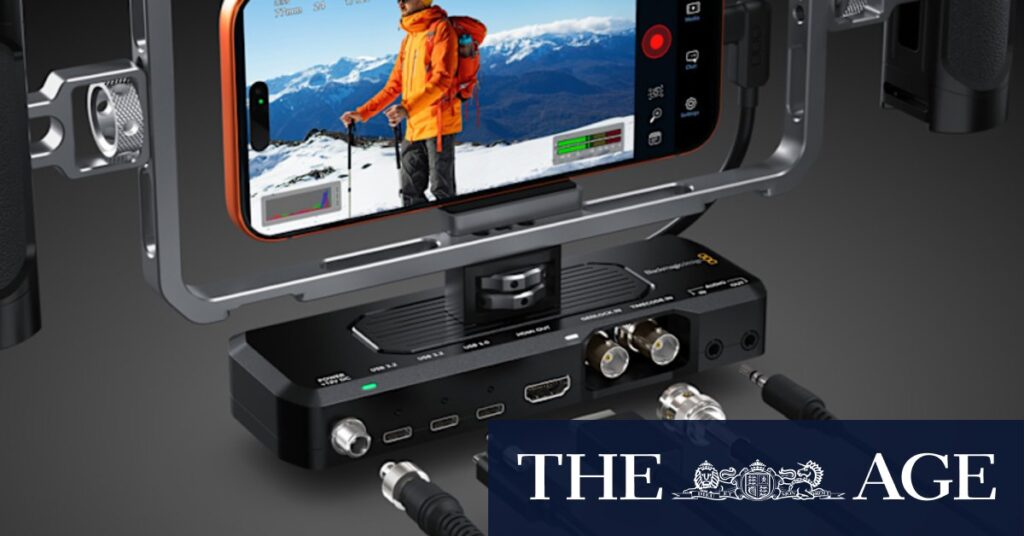
In a groundbreaking development for mobile videography, Blackmagic Design has unveiled an accessory that transforms the latest iPhone 17 Pro Max into a professional cinema camera. This announcement arrives as Apple introduces its most expensive iPhone model yet, priced at a staggering $3,800, featuring an unprecedented 2TB of storage.
The iPhone 17 Pro Max, while not adorned with luxury materials, offers significant storage capacity intended for a specific audience: professional content creators and filmmakers. This demographic values the device’s capability to handle high-resolution video files, a necessity for modern cinematic production. Apple’s recent reveal event highlighted features like genlock and ProRes RAW, terms familiar to industry professionals but largely unknown to the average consumer.
Blackmagic’s Game-Changing Accessory
During the same event, Apple showcased a new accessory developed by Blackmagic Design, a Melbourne-based cinema technology company. This accessory, the Blackmagic Camera ProDock, is designed to enhance the iPhone’s connectivity, allowing it to function like a professional movie camera. Grant Petty, founder and CEO of Blackmagic Design, explained the motivation behind this innovation.
“The cameras on the phones have been getting better and better. So a few years ago, we took the software from our high-end cameras and copied it down into an app called Blackmagic Camera,” said Petty.
The ProDock is akin to a USB-C dock for MacBook Airs, providing the iPhone with professional-grade ports such as 3.5mm stereo inputs and outputs, timecode and genlock for synchronizing multiple cameras, HDMI for external monitors, and additional USB-C ports for solid-state storage. This setup, when combined with the iPhone 17 Pro’s features, aligns the device’s capabilities with those of high-end cinema cameras.
Cost vs. Convenience
The ProDock, priced at $500, alongside the $3,800 iPhone 17 Pro Max, presents a significant investment. However, Petty argues that the convenience of having a professional camera setup in one’s pocket outweighs the cost. The ProDock serves as a bridge, allowing creators to integrate their smartphones into larger production setups without the need for a full cinema camera.
“You’ve already got the phone in your pocket, that’s the point. You can pull it out and use Blackmagic Camera to do cinematic shooting,” Petty noted.
This flexibility is particularly beneficial in dynamic environments, such as protest marches or on-the-go news coverage, where discretion and portability are crucial. The ability to capture high-quality footage without drawing attention is a significant advantage for journalists and filmmakers alike.
Integration with DaVinci Resolve
The Blackmagic Camera app further enhances its utility by syncing seamlessly with DaVinci Resolve, Blackmagic’s industry-standard editing software. This integration allows footage to be uploaded to the cloud as it is recorded, enabling editors to work on content almost in real-time, regardless of their location.
“At some point, you might start to go, ‘OK, well now I want bigger lenses, I want larger sensors, I’ll get a full camera’. But the good thing from our point of view is it’s the same software on the phone [as on the high-end devices], so once you’ve learned one, you know the other,” said Petty.
Blackmagic’s strategy of offering free versions of its app and editing software aims to democratize filmmaking, supporting a new generation of creators who may not have access to expensive equipment. This approach aligns with the company’s long-standing support of Apple’s ecosystem, having been a significant partner in the development of Mac-compatible software.
Secrecy and Innovation
Developing hardware for an unreleased iPhone posed unique challenges for Blackmagic Design. Petty described the process as working under a veil of secrecy, with Apple requiring strict confidentiality from its partners. Despite these constraints, the collaboration has resulted in a product that could redefine mobile filmmaking.
“The trick is to have literally only a couple of people on the project. We had one person taking pictures, a couple of engineers. People that Apple had worked with before, so they trust [them], but at the same time, a large part of the company has no idea what’s going on,” Petty explained.
As Blackmagic and Apple continue to innovate, the boundaries between traditional and mobile filmmaking are increasingly blurred. The iPhone 17 Pro Max, paired with Blackmagic’s ProDock, offers a glimpse into a future where professional-grade video production is accessible to anyone with a smartphone.






